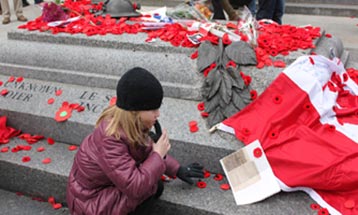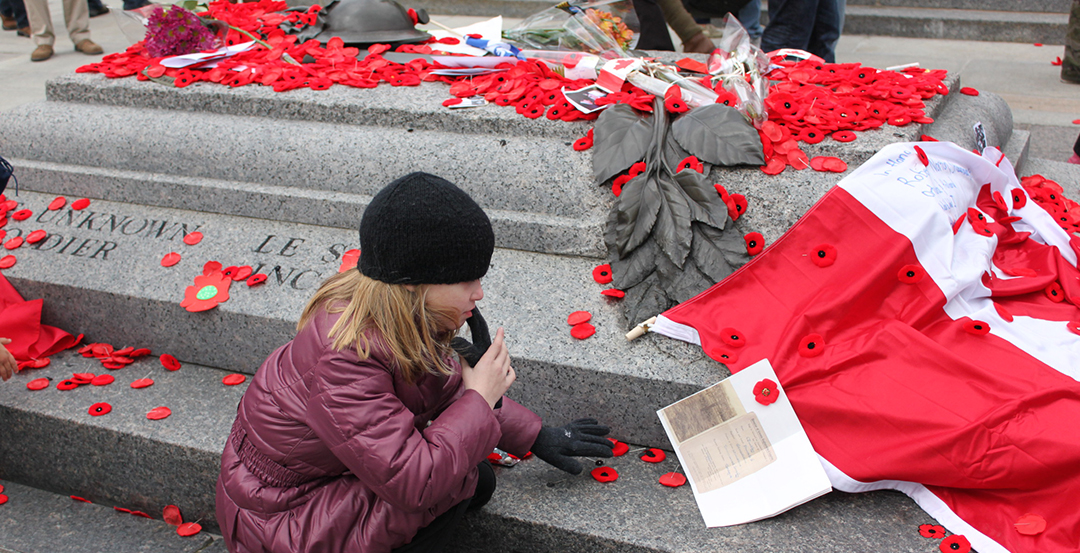These memorials come in many forms and shapes: pillars, plaques, statues, burial grounds and more. They also are constructed out of wood, earth, steel, bronze and polished stone. And they preserve the memory of Canadians who served in wars dating from pre-Confederation times to the present. One or more of these memorials is likely located close to you, wherever you call home across Canada.
Here are five of the many war memorials you can visit to pay tribute to the contributions and achievements of Canada’s Veterans.
1. National War Memorial of Newfoundland and Labrador. This memorial is situated in downtown St. John’s, Newfoundland and Labrador. The stone and bronze memorial is referred to as “national” because its formal unveiling took place in 1924, when Newfoundland was a separate British dominion and not yet a Canadian province. Each year, five official ceremonies are held at the memorial. One of them marks Memorial Day on 1 July. On that day in 1916, hundreds of soldiers of the Newfoundland Regiment were killed or wounded at Beaumont-Hamel on the opening day of the First World War’s Battle of the Somme in France.
2. Sherbrooke War Memorial. In the years immediately following the First World War, Canadians across the land built monuments in an attempt to come to grips with the emotional devastation the war brought to their cities, towns and villages. Sherbrooke, Quebec was one of these places. In 1926, the city unveiled its memorial: a bronze sculpture of an angel soars above three soldiers standing in a trench. The soldiers gaze upward in wonder. Affixed to the structure’s granite base is a bronze plate. Engraved on it are the names of the 248 Sherbrooke residents killed during the conflict. As we now know, the suffering did not end there. Another plate was added following the Second World War to honour those who died in that struggle.
3. Korean War Wall of Remembrance. Located at Meadowvale Cemetery in Brampton, Ontario, the memorial is a curved 60-metre long polished granite wall. The wall lists the names of all Canadian military units that served in the three-year conflict. It also features 516 bronze plaques, one for each Canadian service member who died. Often described as “the forgotten war,” the Korean War is considered by historians to have set the tone for the Cold War rivalry between the democratic countries of the West and the forces of communism.
4. Royal Canadian Air Force Second World War British Commonwealth Air Training Plan Memorial. Canada was dubbed the aerodrome of democracy during the Second World War. Today, Brandon, Manitoba is home to a museum and memorial honouring Canada’s contribution to the training of more than 130,000 Allied pilots and flight personnel during the global conflict. The memorial is a 91-metre granite wall that features 64 granite plaques with the names of Canadians who died serving in the Royal Canadian Air Force in the Second World War, as well as the names of airmen from other Commonwealth countries who died in or near Canada during the conflict. Overlooking the wall is a 2.6-metre-high bronze statue of an airman.
5. God’s Acre – Veterans Cemetery. For almost as long as Canada has been a country, Veterans Cemetery in Esquimalt, British Columbia has been the final resting place for those who lost their lives in service. The 1.1 hectare cemetery was built in 1868 on the site of a turnip field. Today, more than 2,500 military personnel and their family members are buried at the cemetery. Also known as God’s Acre, the site is home to a small chapel and a Cross of Sacrifice, made of granite sculpted in the shape of a shell casing, with a bronze sword mounted on the front.
Date published: 2020-02-10


